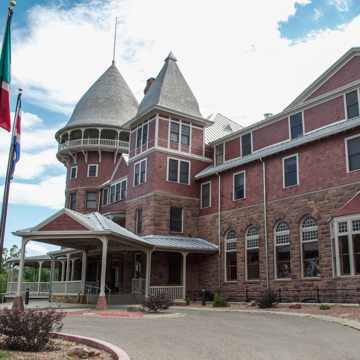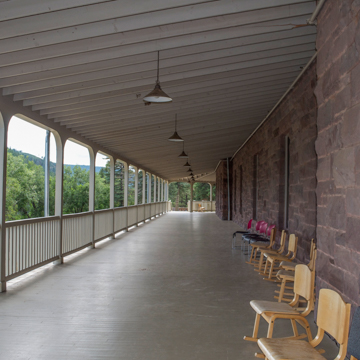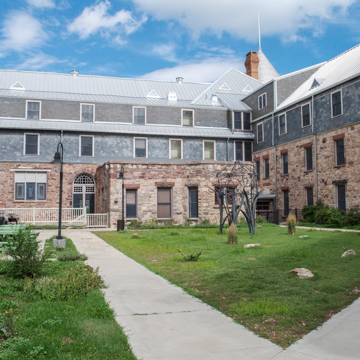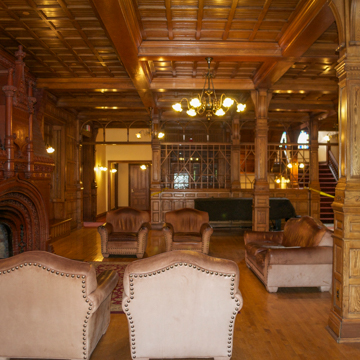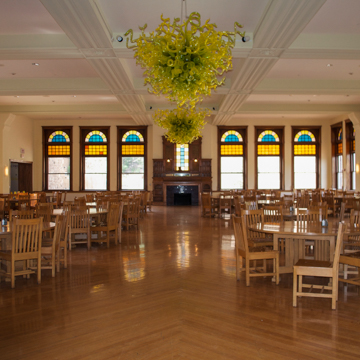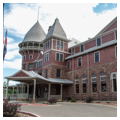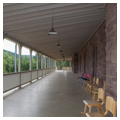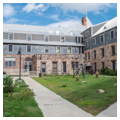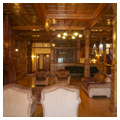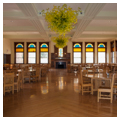You are here
Armand Hammer United World College of the American West
Located near hot springs six miles outside Las Vegas and reached by a specially constructed railroad spur, the Montezuma Hotel included a Fred Harvey restaurant and was conceived as an elegant “watering hole” for both Las Vegas society and tourists traveling by train through New Mexico. Twice burned and twice rebuilt, it also had a short life as a hotel. The Montezuma closed in 1903, after the Atchison, Topeka and Santa Fe Railroad provided a more convenient alternative in the Castañeda Hotel, which opened directly adjacent to the Las Vegas depot in 1899, and just before the competing Fred Harvey resort, El Tovar (Charles Whittlesey, 1905), opened at the Grand Canyon.
The first hotel, erected in 1882 to designs by the Kansas City firm of Jerome, Rice, Moore and Emory, burned down in January 1884. The Chicago firm of Burnham and Root then built a grander hotel at its present hilltop site. When a fire destroyed the hotel’s upper floors, it was rebuilt to a similar design in 1886. Daniel Burnham and John Wellborn Root were leading Chicago architects who had just completed the Montauk Block (1882–1883) and would soon begin work on the Rookery Building (1886). Their selection to design the Montezuma Hotel reflects the prestige that the AT&SF (headquartered in Chicago) attached to this project.
Root’s design for the hotel reflected its rural, mountainous location and, like the previous hotel, was loosely based on the Queen Anne style. This eclectic idiom was broad enough to encompass the Richardsonian Romanesque architecture of the lower floors, with their mass of quarry-faced, red-sandstone walls and arches, and the Shingle Style of the sprawling veranda and tightly volumetric, shingle-clad upper floors and turreted roofs (originally covered with slate). The masonry base also recalls contemporary Burnham and Root office buildings in Chicago, such as the Montauk and Rookery. And at 90,000 square feet of space and with 400 rooms, the hotel was comparable to a Chicago office building in size and complexity.
The hotel’s organization around an interior light court, the double-loaded hallways, the use of doorway transoms for ventilation, the efficient placement of circulation stairs and elevators, and the introduction of electric lighting in the 1886 rebuilding, all reflect lessons learned in Chicago. In keeping with the Queen Anne styling, the interior was elegantly finished with paneled walls and piers, lattice screens, beamed and coffered ceilings, a great Gothic Revival brick fireplace in the lobby, and stained glass windows. The language is domestic, like the houses by Burnham and Root from the same decade, only at a larger scale.
After the hotel closed in 1903, it went through multiple hands. From 1920 until 1932, it was the Montezuma Baptist College; from 1932 until 1970, it was the Montezuma Jesuit Seminary. The building sat vacant until Armand Hammer acquired in 1981 for the United World College. Lacking resources, the United World College left the building in an increasing state of disrepair until it could raise funds for a comprehensive restoration in 1999–2002.
Today, the Montezuma serves as a residence hall and meeting space for the United World College. It is closed to the public, but can be visited and toured by appointment.
References
Brooker, Kathleen Ann. “Railroad Depots in New Mexico: Southwestern Styles and the Masonry Tradition. Master's thesis, University of New Mexico, 1981.
Burnham and Root Montezuma Hotel Drawings, University of New Mexico Center for Southwest Research.
Hoffmann, Donald. The Architecture of John Wellborn Root. Baltimore: Johns Hopkins University Press, 1973.
Ivers, Louise Harris. “The Montezuma Hotel at Las Vegas Hot Springs, New Mexico.” Journal of the Society of Architectural Historians XXXIII, 3 (October 1974): 206-213.
Perrigo, Lynn I. “The Montezuma Hotel,” New Mexico State Register of Cultural Properties Registration Form. Santa Fe, NM, New Mexico Historic Preservation Division, 1974.
Lynn, Sandra. Windows on the Past: Historic Lodgings of New Mexico. Albuquerque: University of New Mexico Press, 1999.
Writing Credits
If SAH Archipedia has been useful to you, please consider supporting it.
SAH Archipedia tells the story of the United States through its buildings, landscapes, and cities. This freely available resource empowers the public with authoritative knowledge that deepens their understanding and appreciation of the built environment. But the Society of Architectural Historians, which created SAH Archipedia with University of Virginia Press, needs your support to maintain the high-caliber research, writing, photography, cartography, editing, design, and programming that make SAH Archipedia a trusted online resource available to all who value the history of place, heritage tourism, and learning.





